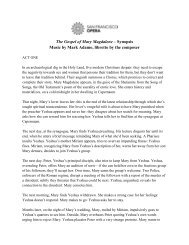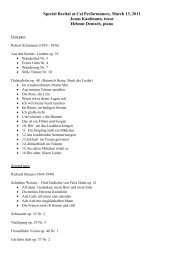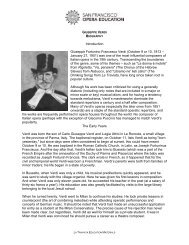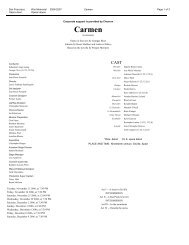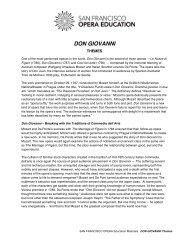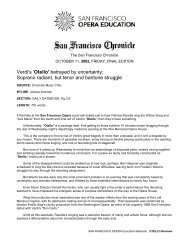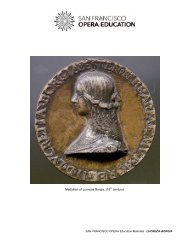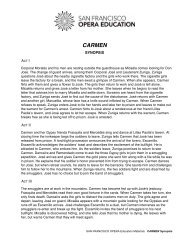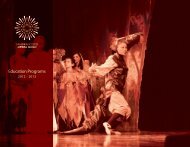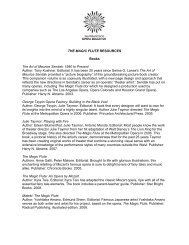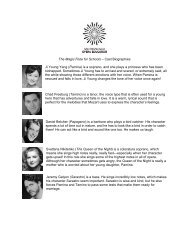Create successful ePaper yourself
Turn your PDF publications into a flip-book with our unique Google optimized e-Paper software.
Another big part of <strong>San</strong> <strong>Francisco</strong> <strong>Opera</strong> that is not found at all opera companies is<br />
the <strong>San</strong> <strong>Francisco</strong> <strong>Opera</strong> Center. The <strong>Opera</strong> Center is dedicated to providing<br />
training for young artists and each year auditions young singers to take part in their<br />
programs. Once accepted, singers receive quality vocal training and are given<br />
exciting performance opportunities that nurture their careers. These opportunities<br />
start in the Merola <strong>Opera</strong> summer training program. The Merola <strong>Opera</strong> Program is<br />
an independent organization that trains young opera singers. Once the singers<br />
have completed the Merola program, they may be considered for further training<br />
within the <strong>San</strong> <strong>Francisco</strong> <strong>Opera</strong> Center in the Adler Fellows Program.<br />
Before operas may be sold or marketed, they must be created and staged. Each<br />
opera has a Director who is hired by the opera company. The Director is<br />
responsible for making decisions about what the themes will be and how the<br />
production will look, from the design of the set to the movement of the singers on<br />
stage. In preparing the production, the Director works with the set, lighting, sound,<br />
costume, and prop designers, who function as a creative team. Each designer then<br />
works with their own crew, a team of crafts people who actually build the show.<br />
The Set Designer is trained in the creative and technical process of designing<br />
backdrops, large props and general background pieces for the opera. The Set<br />
Designer drafts plans and then a model of the set, which is given to the<br />
carpenters and scenic artists who build, paint, and decorate the full-sized set.<br />
The Lighting Designer works with the Director to create the lighting for the<br />
production. Lighting is central to the mood of the opera; a scene set in bright white<br />
light has a different feeling than one set in softer blue lighting, which may denote<br />
evening or a romantic scene.<br />
The Costume Designer is responsible for working with the rest of the creative<br />
team to decide what the dress for the characters will be. In a historically based<br />
production, the Costume Designers do background research into the time period to<br />
make sure that the dress is as appropriate as the sets are. A team of sewing<br />
experts, or stitchers, then measures the performers and assembles the costumes.<br />
The Props Master is responsible for finding, designing and/or constructing the<br />
props that will be used on stage. This can include everything from clothing<br />
accessories like purses, to swords, to wall lamps, to giant puppets. The Props<br />
Designer also works with a crew of craftspeople who take care of the properties<br />
after they have assembled them.<br />
Backstage there are sometimes hundreds of people working to make sure<br />
that the people on stage are under the right lighting and have the right<br />
props and backdrops. These are the Stage Crews; they are responsible<br />
for running the show-- making sure everything happens in the right place,<br />
at the right time.<br />
42



